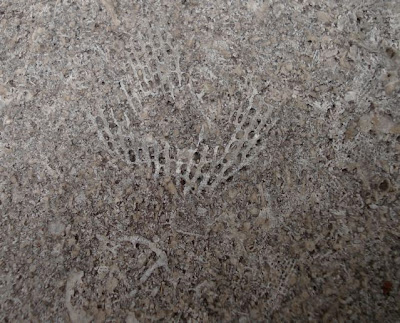With GSA just around the corner, I thought I would highlight some of the local building stones in Portland. Most of what I will be discussing is across the river, in the downtown part of the city. The area is a short walk from the convention center and perhaps might offer a welcome diversion when you get glassy eyed during a talk or two.
I will start with some of the local stones used in buildings. One of the best showcases is the First Congregation Church on the southwest corner of Madison and Park Avenue. Started in 1880 but not completed till 1895, the church formerly had three towers, but only the 185-foot-tall one remains. The base is made of black Oregon basalt, from one of the many great Columbia Plateau basalt flows. These flood basalts, which erupted primarily from 17 mya to 15 mya, are the second most voluminous on the planet. They cover much of the Columbia Plateau, and flowed down the Columbia River basin to Portland. Outcrops of the basalt occur throughout Portland.

The First Congregational Church (from Trey Rice’s Flickr account)
Nestled around the basalt, and checkerboarded with it on the south wall, is the Tenino sandstone, from quarries 20 miles south of Olympia, Washington. Streams washing across a pre-Cascades landscape deposited the sands into deltas that poured into the Pacific Ocean. Fossils found in other parts of the region show that the climate was sub-tropical with abundant growth of palms. The Tenino deposits have been dated at around 50mya. Gray-greenish in color, they provide a nice contrast to the black basalt.
Curiously, basalt cobbles are also used in a rubble wall on the block surrounded by Fourth and Fifth and Market and Mill, but the stones are not from Oregon. Instead, they are Belgian basalt used as ballast in ships that offloaded cargo at the base of Clay Street. This wall originally encased a catholic church and the parishioners wheelbarrowed the stones up from the waterfront for their building project. As Ralph Mason notes in his splendid guide to Portland’s stone (Oregon Geology Vol. 47. No. 11, which provided most of the information for this article), the devout could have gotten basalt from a nearby cliff “which is several thousand miles closer and a downhill haul.” They say that suffering builds character, and churches.
I will end with a boring building architecturally but a fascinating one geologically. Two types of widely used stone clad the building that takes up the block between Jefferson and Columbia and 6th and Broadway. What makes it interesting is the great unconformity between the base and the upper floors. The 3.5 bya Morton gneiss in all its gaudy glory covers the base and atop it sits the 330 mya Salem Limestone, both stones of which I have blogged about before.

Oregonian building (from Wikipedia)
I have focused only on the older buildings in Portland. Many new structures showcase stone from around the world. As noted at the beginning, I highly recommend a tour. Mason also wrote an earlier tour of Portland buildings for The Ore Bin, volume 27, no. 4, April 1965.

 And finally, I also found another Morton Gneiss building, on the south side of Burnside between NW 9th and NW 8th Avenue (just a block away from Powells). Again, the building is architecturally uninspired but with gorgeous stone. This time, however, the builders chose to use a white marble with black streaks instead of limestone. I suspect it is a Vermont marble. That’s all for now.
And finally, I also found another Morton Gneiss building, on the south side of Burnside between NW 9th and NW 8th Avenue (just a block away from Powells). Again, the building is architecturally uninspired but with gorgeous stone. This time, however, the builders chose to use a white marble with black streaks instead of limestone. I suspect it is a Vermont marble. That’s all for now. 


